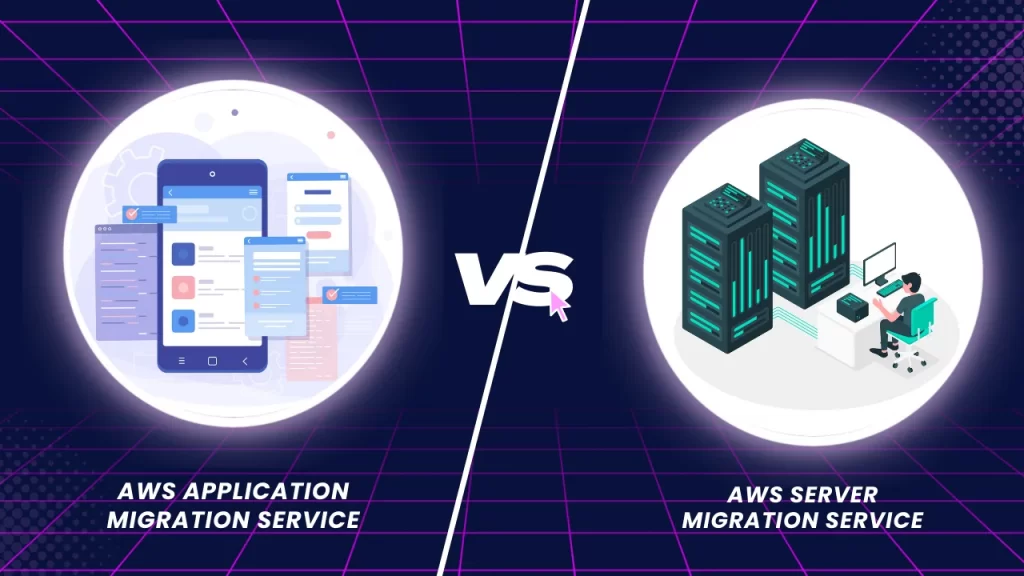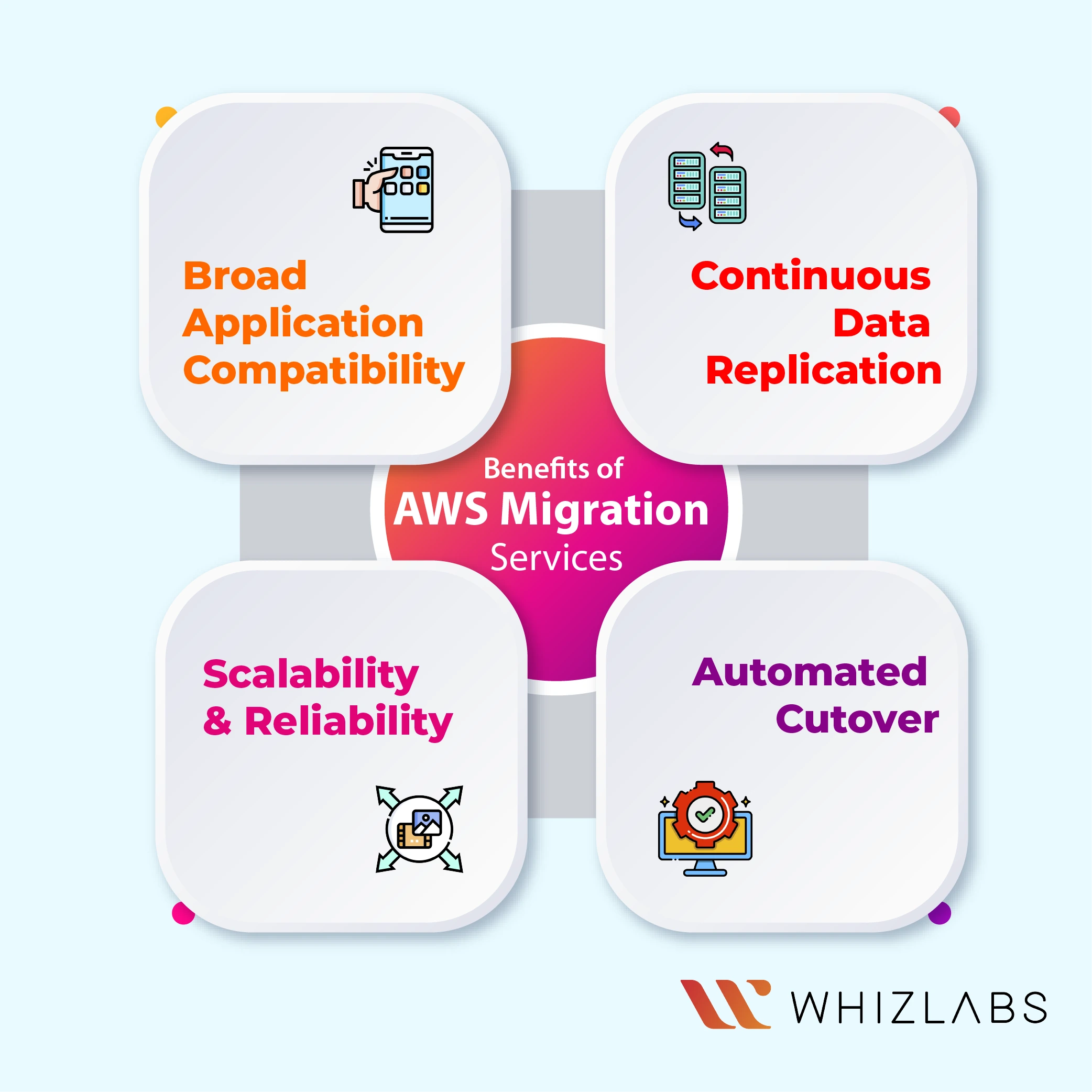AWS Application Migration Service and the Server Migration Service are widely adopted tools by many businesses to optimize their infrastructure and open up new opportunities for their apps in today’s quickly changing business environment.
With the goal of assisting you in making an informed choice on your migration journey, we will examine the key distinctions and use cases of each service in this blog.
Let’s dig in!
Key Features of Application Migration vs Server Migration Service
An Overview of AWS Application Migration Service Comparison:
AWS Application Migration Service helps us to migrate our entire applications to the AWS cloud. It simplifies the migration process, minimizing downtime and enabling organizations to modernize their infrastructure effortlessly. When choosing the right migration service, consider factors such as the type of applications you are migrating, your current infrastructure, and your specific requirements. Additionally, AWS continuously updates and expands its services, so it’s essential to check for the latest offerings and features as of your current date in 2023.
AWS Migration Solutions and Tools
Application migration solutions and tools refer to the processes and technologies used to move software applications and their associated data from one environment or platform to another, This can include transitioning applications between servers, data centers, cloud providers, or from on-premises to cloud-based infrastructures.
Application-Centric Migration
Application-centric migration within the AWS Application Migration Service revolves around the philosophy of migrating entire application stacks as cohesive units, rather than focusing solely on individual components or servers.
Benefits of AWS Migration Services
This approach acknowledges the intricate web of dependencies, configurations, and interactions that constitute modern applications. By prioritizing the migration of complete applications, AWS Application Migration Service ensures that the migration process is holistic, preserving the integrity, functionality, and performance of the application in the cloud environment.
Broad Application Compatibility
Broad application compatibility refers to the ability of a migration solution to support a wide range of application types, spanning from simple web applications to complex enterprise-grade software.
In the context of the AWS Application Migration Service, this compatibility ensures that organizations can migrate applications of varying complexities and functionalities, regardless of their underlying architecture or technology stack.
Unlike a one-size-fits-all approach, broad application compatibility recognizes that modern enterprises utilize a diverse set of applications to drive their operations.
These applications might include e-commerce platforms, customer relationship management (CRM) systems, content management systems (CMS), databases, analytics tools, and more. Each of these applications has unique characteristics, dependencies, and requirements, making a flexible and versatile migration solution essential.
Continuous Data Replication
Continuous data replication is a technique that involves real-time or near-real-time copying of data from a source to a target environment.
Unlike traditional batch-oriented methods, continuous replication ensures that changes made to the source data are promptly and automatically replicated to the target location. This approach minimizes data loss and discrepancies, allowing the target environment to remain up-to-date with the latest changes from the source.
In the context of the AWS Application Migration Service, continuous data replication enables a smooth and seamless migration experience. It ensures that the data in the target AWS environment remains synchronized with the source environment, reducing the risk of data inconsistencies and disruptions during the migration process.
Automated Cutover
The Application Migration Service streamlines the cutover phase, which is a critical juncture in the migration process. Automation minimizes disruptions and ensures a smooth transition to the AWS environment.
Scalability and Reliability
Leveraging AWS’s robust cloud infrastructure, the service ensures that migrated applications can scale seamlessly to accommodate changing workloads while maintaining high availability.
Use Cases
- Complex Application Dependencies: Organizations dealing with applications with intricate dependencies should consider the Application Migration Service. Its comprehensive approach ensures a seamless migration without compatibility issues.
- Minimal Downtime Requirement: For applications that require minimal downtime, the Application Migration Service’s automated cutover and continuous data replication are invaluable.
- Application Modernization: The service offers opportunities for application modernization during migration. Organizations can update configurations and integrate AWS services to enhance application capabilities.
- Holistic Migration: When migrating applications with multiple interconnected components, the Application Migration Service’s comprehensive approach ensures a smooth and coordinated transition.
AWS Server Migration Service
In contrast, the AWS Server Migration Service is designed for organizations migrating virtualized servers to the AWS cloud. It is particularly advantageous for scenarios involving the migration of a large number of virtual machines or servers.
Server-Centric Migration
Server-centric migration, at its core, revolves around the approach of prioritizing individual servers as the primary unit of migration. Unlike application-centric migration which focuses on migrating entire application stacks, server-centric migration is particularly well-suited for scenarios where the migration of multiple virtualized servers is the central objective.
In the context of AWS Server Migration Service, server-centric migration involves the seamless migration of on-premises virtual machines or servers to the AWS cloud. This approach recognizes that many organizations have complex server architectures with interdependent applications, services, and configurations.
By migrating servers as complete entities, server-centric migration seeks to ensure that the server’s functionality, performance, and connectivity are maintained post-migration.
Integration with Existing Tools
Integration with existing tools is a pivotal aspect of any cloud migration strategy. It involves the alignment of migration processes, procedures, and data with the tools and platforms already in use within an organization’s on-premises environment.
In the context of AWS SMS, integration refers to the service’s compatibility with popular virtualization platforms, specifically VMware, which many organizations use for their virtualized infrastructure.
AWS SMS is designed to simplify the migration of on-premises workloads to the AWS cloud. A key advantage of SMS is its seamless integration with existing virtualization setups, allowing organizations to leverage their investments in virtualization technologies during the migration process. This integration minimizes disruption, reduces complexity, and accelerates the migration journey.
Incremental Replication
Incremental replication is a data synchronization technique employed during the migration of servers to cloud environments. Unlike traditional methods that involve copying an entire dataset each time, incremental replication focuses on transferring only the changes made since the last replication. This targeted approach significantly reduces the amount of data transferred during subsequent replications, resulting in enhanced efficiency and reduced migration time.
In the context of the AWS Server Migration Service, incremental replication plays a pivotal role in minimizing downtime, optimizing resource utilization, and ensuring a smoother migration experience. It is particularly beneficial for organizations dealing with large datasets, frequent data changes, and stringent downtime constraints.
Agent-Based Setup: To facilitate migration, the service utilizes a lightweight agent installed on the source server. This agent-based setup streamlines the migration process and reduces manual intervention.
Resource Consolidation
Resource consolidation is a strategic approach that involves migrating multiple servers or virtual machines (VMs) onto a single, larger instance or set of instances in the cloud. The goal is to maximize the utilization of computing resources while reducing the number of physical or virtual servers required. By consolidating resources, organizations can optimize performance, enhance efficiency, and potentially realize significant cost savings.
In the context of the AWS Server Migration Service, resource consolidation refers to migrating multiple servers or VMs onto fewer instances within the AWS cloud. This process involves assessing the workloads and characteristics of the existing servers, determining the optimal instance types, and then executing the migration in a way that optimizes resource utilization.
Use Cases
AWS Server Migration Service
- Virtualized Server Migration: The Server Migration Service is an ideal choice for organizations focused on migrating a significant number of virtualized servers to the cloud.
- Existing Virtualization Environments: Organizations with established virtualization setups, such as those using VMware, can leverage the Server Migration Service’s integration capabilities for a seamless migration process.
- Efficiency in Migration: When efficiency is a priority, especially in terms of data transfer and resource utilization, the incremental replication mechanism of the Server Migration Service offers distinct advantages.
Factors Influencing Your Migration Strategy
The decision to choose between the AWS Application Migration Service and the Server Migration Service should be guided by several factors unique to your organization’s needs and migration objectives.
- Application Complexity: The Application Migration Service is well-suited for applications with complex dependencies that need to be migrated as a cohesive unit.
- Downtime Tolerance: Organizations with minimal tolerance for downtime may find the Application Migration Service’s automated cutover and continuous data replication appealing.
- Modernization Goals: If modernizing applications during migration is a priority, the Application Migration Service offers opportunities for configuration updates and integration with AWS services.
- Server Virtualization: If your primary focus is on migrating virtualized servers, the Server Migration Service aligns better with this objective.
- Integration with Existing Setup: For seamless integration with existing virtualization platforms, the Server Migration Service’s compatibility with platforms like VMware is advantageous.
- Resource Optimization: Organizations seeking resource consolidation and potential cost savings through server and application consolidation might find the Server Migration Service appealing.
- AWS migration best practices Including the planning and testing are crucial for a transition. It’s also important to optimize cost efficiency by using AWS tools. By following these practices you can ensure a cost-effective journey as you migrate to the cloud with AWS.
The former excels in complex application migrations, minimal downtime scenarios, and holistic migration objectives. In contrast, the latter shines in migrating virtualized servers, optimizing resource utilization, and seamlessly integrating with established virtualization setups. Ultimately, both the AWS Application Migration Service and the Server Migration Service empower organizations to unlock the full potential of the AWS cloud.
By understanding their features, benefits, and use cases, you can embark on a migration journey that aligns seamlessly with your business goals and sets the stage for a successful and transformative migration experience. Whether you choose to migrate complete application stacks or virtualized servers, AWS offers a robust set of tools to facilitate your cloud migration journey.
Conclusion
In the dynamic realm of cloud migration, selecting the appropriate AWS migration service is pivotal to the success of your migration journey.
The choice between the AWS Application Migration Service and the Server Migration Service should be guided by the unique characteristics of your applications, your existing infrastructure, and your overall migration objectives.
If you want to get practical experience in this AWS migration service, try our AWS hands-on labs and AWS sandboxes.
- Top 20 Questions To Prepare For Certified Kubernetes Administrator Exam - August 16, 2024
- 10 AWS Services to Master for the AWS Developer Associate Exam - August 14, 2024
- Exam Tips for AWS Machine Learning Specialty Certification - August 7, 2024
- Best 15+ AWS Developer Associate hands-on labs in 2024 - July 24, 2024
- Containers vs Virtual Machines: Differences You Should Know - June 24, 2024
- Databricks Launched World’s Most Capable Large Language Model (LLM) - April 26, 2024
- What are the storage options available in Microsoft Azure? - March 14, 2024
- User’s Guide to Getting Started with Google Kubernetes Engine - March 1, 2024


